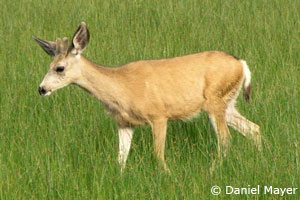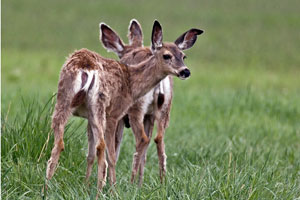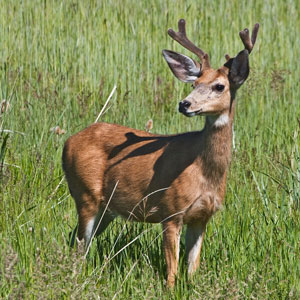

|
Mule Deer (Odocoileus hemionus) What they look like: The Mule Deer is a large mammal. The coat of mule deer ranges from dark brown gray, dark and light gray to brown and even reddish. The rump patch may be white or yellow, while the throat patch is white. The white tails of most mule deer end in a tuft of black hairs, or less commonly in a thin tuft of white hairs (see photo of a young Mule deer). Weight: 95 to 330 lbs; 
Where they live: Mule Deer are found throughout Washington, including the islands, in hardwood and coniferous forests, dense shrubs or other growth stages with small trees or shrubs. They are also found in meadows, and grasslands, including alpine meadows, near forest. The availability of browse in forest understory is important for them.
Click the range map to learn more about the distribution of Mule deer in Washington. View a map of the distribution of White-tailed deer in Washington. What they eat: Mule Deer are herbivores; they browse or graze depending on the season. They feed on a variety of vegetation including green plants, nuts and corn, and trees and twigs. They like to browse on Douglas fir and Ponderosa pine. 
Behavior: The Mule Deer carries its thin, black-tipped tail drooped, unlike the uplifted, bushy white tail of its cousin. Mule Deer have large ears that move constantly and independently, from whence they get their name, "Mule" or "Burro Deer." They do not run as other deer, but have a distinctive bounding leap (stotting) over distances up to 8 yards, with all 4 feet coming down together. In this fashion, they can reach a speed of 45 m.p.h. for short periods. (DesertUSA.com) Mule Deer are active primarily in mornings and evenings.
Did you know?

Mule Deer photo More information: Mule Deer - Animal Diversity Web |
Animal silhouettes available to purchase »
Photos by Natures Pics
Home | About Us | How to Participate | Biodiversity Modules | Projects | Maps | News | Resources